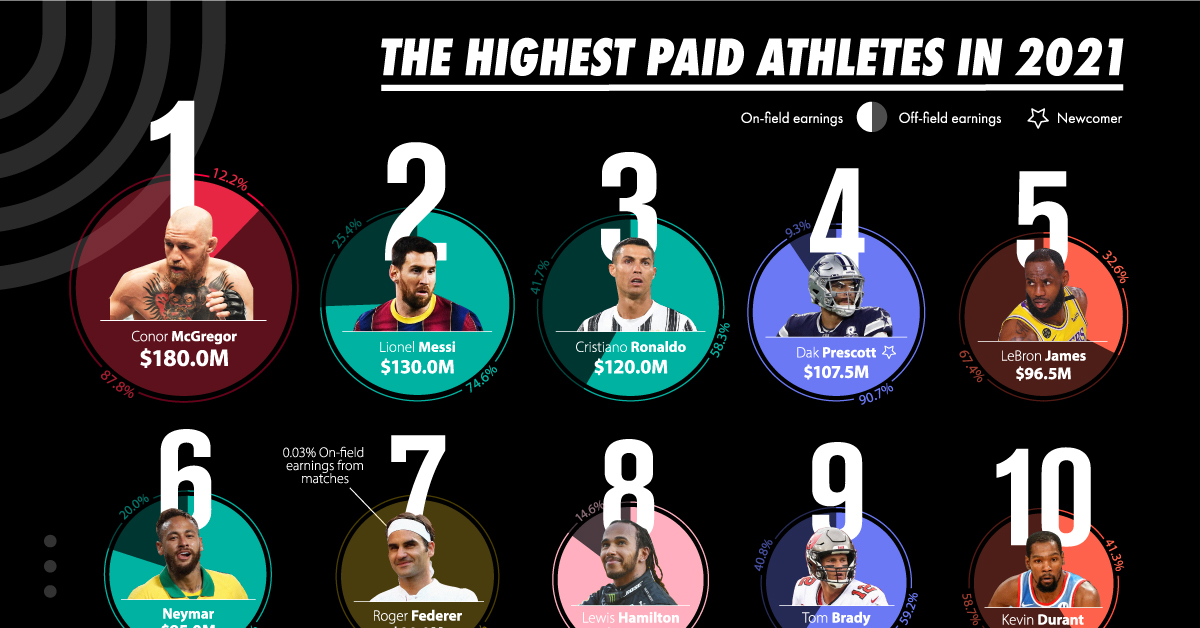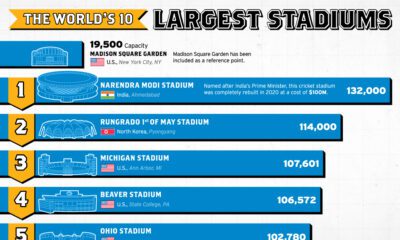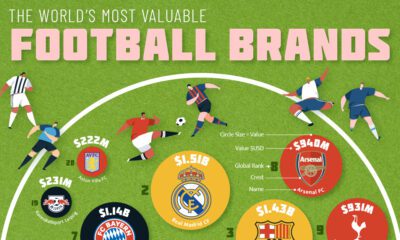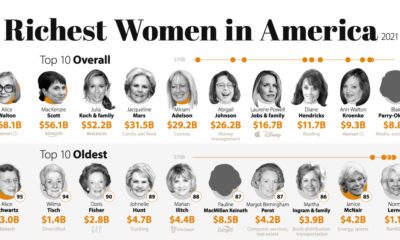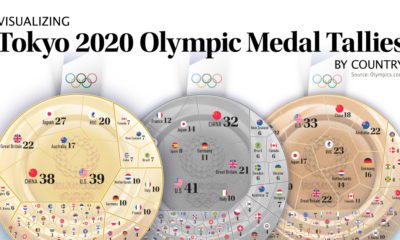Misc
Visualizing the Highest-Paid Athletes in 2021
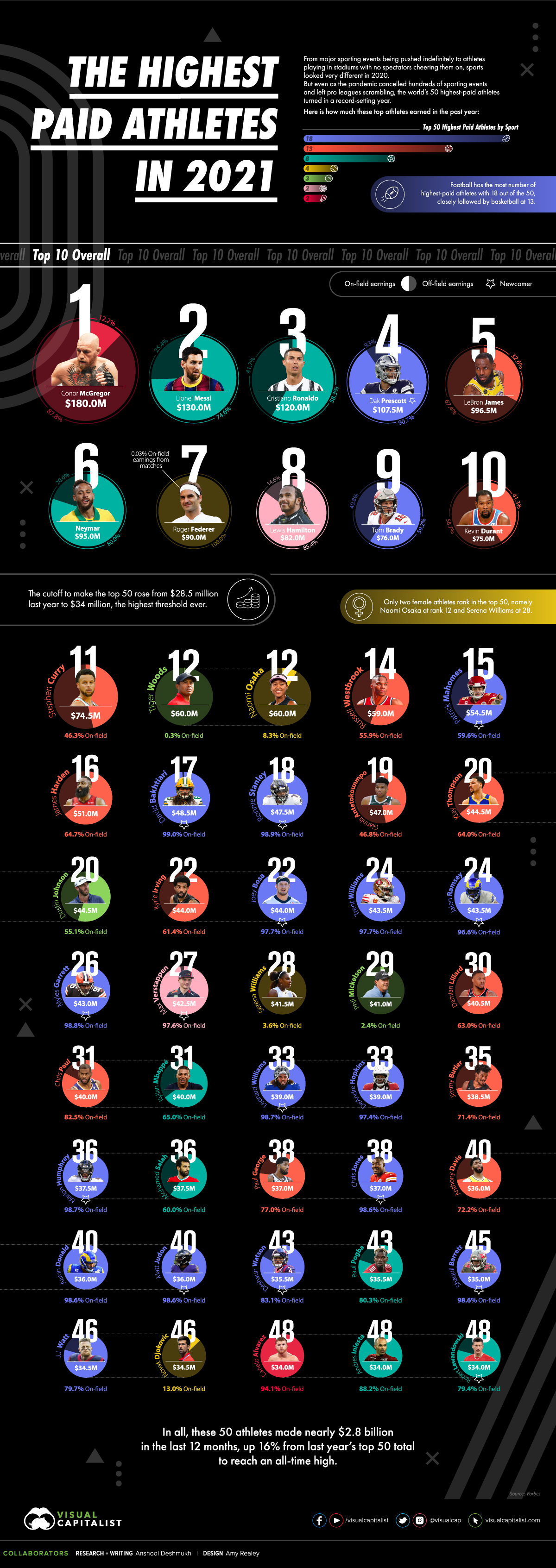
Who Were the Highest-Paid Athletes in 2021?
The financial figures in sport are enormous. The highest-paid athletes in the world make tens of millions, or even hundreds of millions per year.
The global pandemic put a significant dent in the commercial aspect of many sports. Even though the teams and their owners earned significantly less during this period, individual athletes actually thrived.
According to the Forbes annual rankings of the world’s highest-paid athletes for 2021, the top 50 of them turned in a record-setting year and made nearly $2.8 billion in 12 months, beating 2019’s record total by more than $150 million.
Highlights of the Year
This year’s list had a multitude of names making the big bucks. Here are some of the highlights:
Connor McGregor is 2021’s highest-paid athlete
MMA fighter Connor McGregor tops the list with a whopping $180 million earned in 2021. According to McGregor, this has been a long time coming, who in 2016 infamously boasted to soccer star Cristiano Ronaldo that he’d overtake him one day as sports’ highest-paid star.
Roger Federer lands at the 7th spot
Roger Federer’s on-field earnings for 2021 were a mere $0.03 million, but he still lands in the 7th spot. Recovering from a knee injury, Roger Federer made nearly all of his $90 million in earnings from sponsorships.
Naomi Osaka is the only woman among the top 15 earners
Naomi Osaka is the highest-paid female athlete on this list and the only one to crack the top 15. Over the last year, she won her second Australian and U.S. Open titles, while also receiving media attention for her stances on mental health and racial equality.
Dak Prescott had the highest on-field earning
The highest on-field earning by any player was by Dallas Cowboys quarterback Dak Prescott who earned $97.5 million in 2020. In March of 2021, Prescott signed a four-year, $160 million contract extension with the Cowboys, with a $66 million signing bonus.
Motor racing’s top earners
Seven-time Formula 1 world champion Lewis Hamilton and newcomer and current world championship leader Max Verstappen are the only two from the sport of auto racing on the list.
Significance in Numbers
Let’s take a look at the most notable numbers in this year’s list:
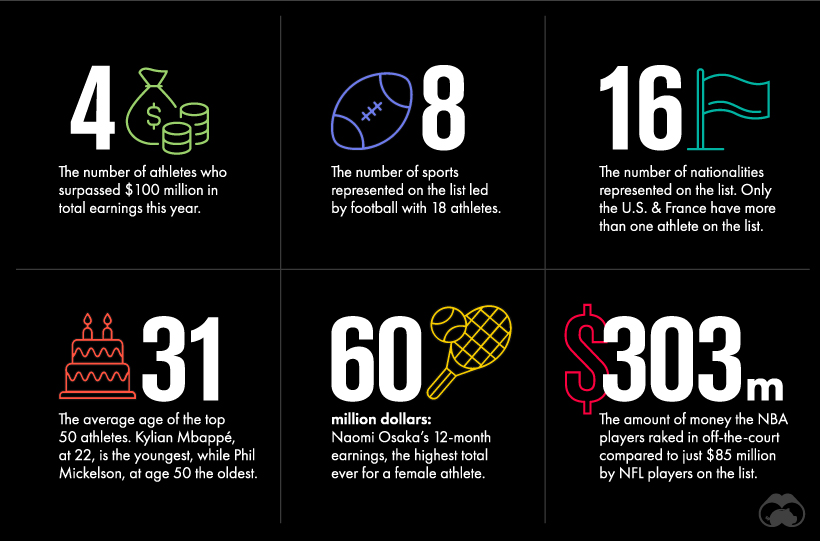
What the Future Holds for the Highest-Paid Athletes
With contracts and endorsement deals growing bigger every year, the number of athletes breaking the $100 million mark will continue to increase.
While supermax contracts and weekly wages make the headlines, endorsement deals account for a significant portion of an athlete’s income. And that piece of the pie is growing steadily. The off-the-field earnings of the top 50 athletes reached $1.04 billion this year, compared with $556 million back in 2012.
If the last year has been any indication, socio-political messages and social media will likely play an essential part in how athletes are perceived and their endorsements are impacted as we go forward in the future.
United States
Charted: What Southeast Asia Thinks About China & the U.S.
A significant share of respondents from an ASEAN-focused survey are not happy about rising American and Chinese influence in the region.

What Southeast Asia Thinks About China & the U.S.
This was originally posted on our Voronoi app. Download the app for free on iOS or Android and discover incredible data-driven charts from a variety of trusted sources.
This chart visualizes the results of a 2024 survey conducted by the ASEAN Studies Centre at the ISEAS-Yusof Ishak Institute. Nearly 2,000 respondents were asked if they were worried or welcoming of rising Chinese and American geopolitical influence in their country.
The countries surveyed all belong to the Association of Southeast Asian Nations (ASEAN), a political and economic union of 10 states in Southeast Asia.
Feelings Towards China
On average, a significant share of respondents from all 10 countries are worried about rising influence from both the U.S. and China.
However, overall skepticism is higher for China, at 74% (versus 59% for U.S.).
| Country | Worried About Growing 🇨🇳 Influence | Welcome Growing 🇨🇳 Influence |
|---|---|---|
| 🇧🇳 Brunei | 58% | 42% |
| 🇰🇭 Cambodia | 66% | 34% |
| 🇮🇩 Indonesia | 57% | 43% |
| 🇱🇦 Laos | 68% | 32% |
| 🇲🇾 Malaysia | 56% | 44% |
| 🇲🇲 Myanmar | 95% | 5% |
| 🇵🇭 Philippines | 81% | 19% |
| 🇸🇬 Singapore | 74% | 26% |
| 🇹🇭 Thailand | 84% | 16% |
| 🇻🇳 Vietnam | 96% | 4% |
| Average | 74% | 27% |
The recently-cooled but still active territorial concerns over the South China Sea may play a significant role in these responses, especially in countries which are also claimants over the sea.
For example, in Vietnam over 95% of respondents said they were worried about China’s growing influence.
Feelings Towards America
Conversely, rising American influence is welcomed in two countries with competing claims in the South China Sea, the Philippines (69%) and Vietnam (55%).
| Country | Worried About Growing 🇺🇸 Influence | Welcome Growing 🇺🇸 Influence |
|---|---|---|
| 🇧🇳 Brunei | 73% | 27% |
| 🇰🇭 Cambodia | 58% | 42% |
| 🇮🇩 Indonesia | 73% | 27% |
| 🇱🇦 Laos | 79% | 21% |
| 🇲🇾 Malaysia | 68% | 32% |
| 🇲🇲 Myanmar | 45% | 55% |
| 🇵🇭 Philippines | 32% | 69% |
| 🇸🇬 Singapore | 37% | 63% |
| 🇹🇭 Thailand | 80% | 20% |
| 🇻🇳 Vietnam | 45% | 55% |
| Average | 59% | 41% |
Despite this, on a regional average, more respondents worry about growing American influence (59%) than they welcome it (41%).
Interestingly, it seems almost every ASEAN nation has a clear preference for one superpower over the other.
The only exception is Thailand, where those surveyed were not a fan of either option, with 84% worried about China, and 80% worried about the U.S.
-

 Best of6 days ago
Best of6 days agoBest Visualizations of April on the Voronoi App
-

 Brands2 weeks ago
Brands2 weeks agoHow Tech Logos Have Evolved Over Time
-

 Energy2 weeks ago
Energy2 weeks agoRanked: The Top 10 EV Battery Manufacturers in 2023
-

 Demographics2 weeks ago
Demographics2 weeks agoCountries With the Largest Happiness Gains Since 2010
-

 VC+2 weeks ago
VC+2 weeks agoVC+: Get Our Key Takeaways From the IMF’s World Economic Outlook
-

 Demographics2 weeks ago
Demographics2 weeks agoThe Countries That Have Become Sadder Since 2010
-

 Money2 weeks ago
Money2 weeks agoCharted: Who Has Savings in This Economy?
-

 Technology1 week ago
Technology1 week agoVisualizing AI Patents by Country




